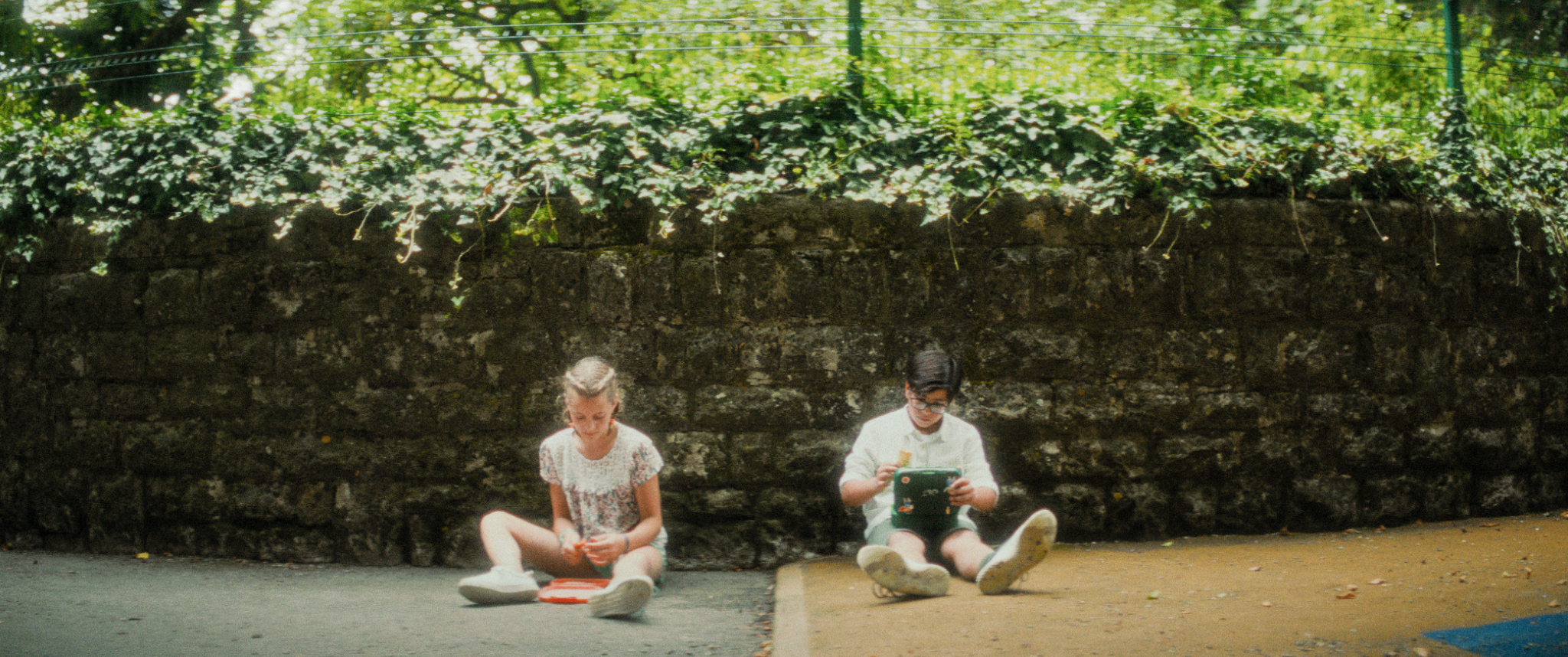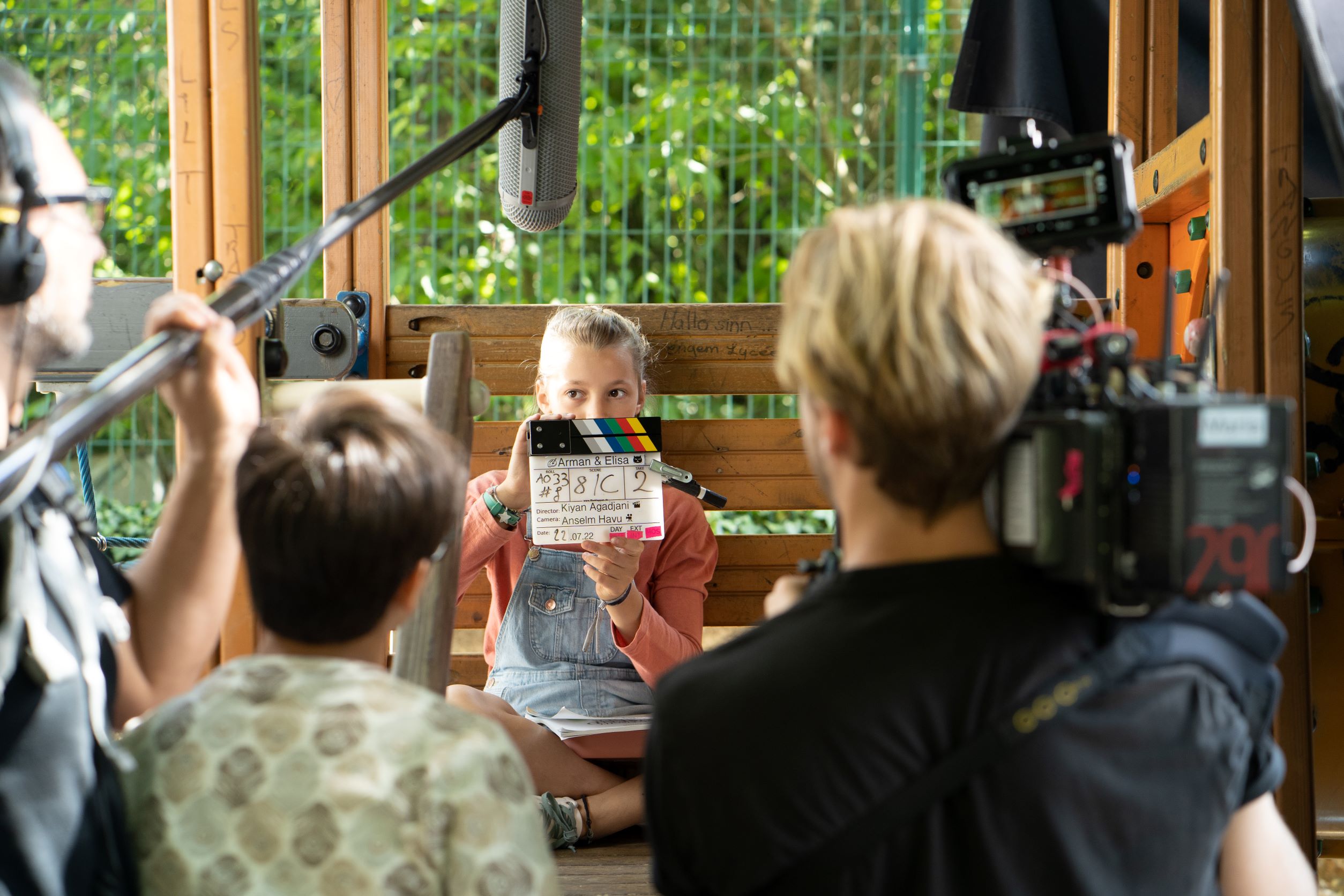28 nov. 2023ARMAN & ELISA

Foto: Arman & Elisa, © Wadi Films
When Kiyan Agadjani introduced the North American audience at the Austin Film Festival to Quiddegebeess, Colette a Fernand, and a Moselle-Franconian language that is only spoken by about 400,000 native speakers somewhere in Europe, he feared people wouldn’t understand the references. In fact, they didn’t, and it’s the best reaction he could have hoped for.
While watching Arman & Elisa, Kiyan’s second short film, many viewers in Austin found themselves stepping into the shoes of Arman (Shayan Arendt), an Iranian boy who recently moved to Luxembourg, speaking only his mother tongue, Farsi. At his new school, he meets Elisa (Elise Krieps), who only speaks Luxembourgish. Like Arman, many people in the mostly English-speaking crowd felt like a fish out of water, as Kiyan puts it. They didn’t know much of what they encountered within the film, and yet they understood a lot.
Arman & Elisa received a lot of recognition at the renowned Austin Film Festival from both the jury and audience members. Out of 6,000 submissions from all over the world, it won the award for the best Narrative short and is now qualified for the Academy Awards in 2025.

From Kent to Minett
Kiyan Agadjani, 25 years of age, is a Luxembourgish screenwriter and film director with Iranian roots. After his film studies at Kent University in England and the accomplishment of his very first short film, George Barton, with a budget of only £500, he makes his way back to the Grand Duchy in 2022.
“Ech war en halleft Joer zeréck dee Moment an ech hat net vill Kontakter an net vill Jobs an der Filmindustrie. Dat war wierklech haart an ech hu mer geduecht, OK, gutt, et gëtt awer lo Zäit, ech muss lo direkt lassleeën. [...] Elo schreifs du däin éischte [lëtzebuergesche] Kuerzfilm.” From that moment on, things went quickly. In February 2022, the script was written; in March, the submission to the Luxembourgish Film Fund took place; in July, the film was shot; and in October 2022, the post-production came to a conclusion.

What sounds like a breeze was, however, a demanding process because “writing is not easy,” as Kiyan explains. Deciding on what idea is worth developping, what story is worth telling, and foremost, what emotions you want to express, is not a simple task. “Ech versichen ëmmer eppes ze fannen, wat mech beréiert, wat villäicht och aner Leit géif beréieren, an ech hunn zeréck u meng Kandheet geduecht.”
When Arman met Elisa
It all started with a lunch box. For Kiyan, it was the memory of a scene he experienced when he was in primary school. When he and one of his classmates sat down together to enjoy their packed lunch during the break, they noticed that the contents of their lunch boxes looked very different. While Kiyan’s box contained Iranian snacks, the other boy brought along a rather Luxembourgish jelly sandwich, eng Gebeesseschmier. This instantly sparked their childlike curiosity, and they shared a bonding moment that served as inspiration for his film.

In the school yard of Kiyan's former primary school in Esch-sur-Alzette, Arman and Elisa find themselves in a very similar situation. Out of curiosity, they taste each other’s food and quickly proceed in a cultural exchange without words. Despite their linguistic differences, they succeed in communicating, unlike the adults around them, who, although speaking the same language, still manage to talk past one another, complicating things in the process.
“Emotion over everything!” This is the baseline of the stories Kiyan tells. It is empathy and warmth in human interaction that he’s searching for within and around his films. Inspired by the Iranian New Wave, Kiyan is convinced that children have access to a truth often lost to adults. Children tend to encounter new things with curiosity rather than caution, to be more receptive to and expressive of their true emotions, and to ask questions rather than to assume things based on the political baggage one often carries, he says.
Right from the start, the young director knew that his story had to be told from the perspective of children. Starting from the golden rule of filmmaking that says, Show, don’t tell! Kiyan goes even further and asks, What if I can’t tell? Since his protagonists don’t share a common language, the story itself therefore had to rely on very visual language. As such, the cinematography of Anselm Havu follows Arman and Elisa on eye level and only deviates in the final moments of the film. There, we see the camera zooming out far above the heads of Arman and the other kids in the school yard, forcing adult viewers to look down on them, as they all too often do.

Kiyan holds up a mirror to the spectators. “Mir musse Kanner méi eescht huelen,” he explains passionately. “Mir behandelen si ëmmer als onvollkomme Persounen, déi et net besser wëssen. Si hu just manner Joren op der Äerd verbruecht, si hu just manner Erfarung. Dat heescht net, datt si manner d‘Wourecht kennen, manner receptiv si fir richteg Emotiounen oder net richteg vu falsch kënnen ënnerscheeden.“
Behind the Zeen
“Mir ass et wichteg, ee Film net an engem Vakuum ze schreiwen. [...] Ech muss erausgoen, ech muss e Kaffi drénke goen a mat Leit schwätzen. [...] Fir eng Mënschlechkeet an déi Geschicht eranzebréngen, muss ech och aner Gedanken erabréngen, ech kann dat net eleng maachen”, Kiyan tells me. He believes in the realisation of a collaborative vision in filmmaking.
This is all the more true while working with crew members and actors on set. “Déi Freed, déi ech dobäi hunn ass onglaublech,” he points out in excitement. “Et ass effektiv do, wou ech am meeschten opbléien. [...] Du häss mech um Set solle gesinn. Ech sinn do ronderëm gelaf, ech hu mat jidderengem geschwat. Et hätt ee kënne mengen, ech wier op Koks”, he laughs.

Nevertheless, despite all the joy it brings him, Kiyan finds it crucial to note that working in film is not easy. There is much pressure and much self-doubt you have to deal with as an independent in the creative business, and you face many irregularities and insecurities. “Ech hätt dat gäeren virun zwee Joer gewosst. [...] Deemools hunn ech geduecht, et gesäit alles sou einfach aus, firwat hunn ech sou eng schwéier Zäit. Ech hätt gäeren héieren, dass ee seet, Jo, et ass net einfach, et ass haart Aarbecht, sief prett dofir!”
If you want to do film, be sure that you put your heart and soul into it, Kiyan concludes. His biggest tip, however, is to be a kind person; it’s simple yet effective. Other than that, there is no manual to becoming a film director, he says.

Arman & Elisa is a warm-hearted study on the lightness of friendship at a young age, its instinctive, less biased nature, and its potential of overcoming barriers out of pure curiosity and empathy — or rather, its potential of not having them in the first place.
After having been extremely well received at the Austin Film Festival, Kiyan’s second short film now continues its festival run, delivering its universal message(s) to an even wider international audience — potentially, with a bit of luck, even at the Oscars in 2025. In the long run, Kiyan hopes to be able to show Arman & Elisa for educational purposes in Luxembourgish schools.
For now, Kiyan Agadjani is working on his next projects, involving yet another short film. There is no doubt that we’ll hear about them anytime soon.
Les plus populaires
- 26 juin. 2024
- 28 juin. 2024
- 05 juil. 2024
- 04 juil. 2024
ARTICLES
Videos
26 juil. 2024TAPAGE avec Ruth Lorang
Articles
22 juil. 2024Le fabuleux destin de Raphael Tanios
Videos
19 juil. 2024

